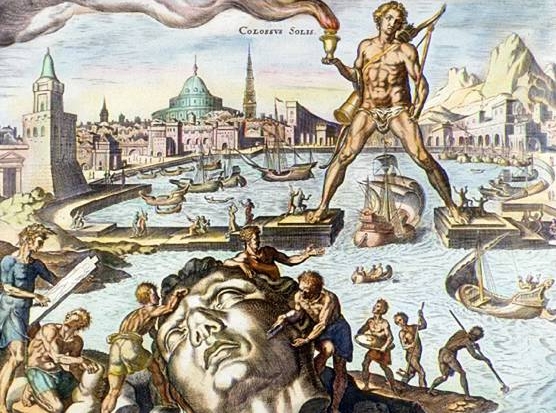Previously in Cliopolitan,
I discussed the magnificent and all-too-short-lived Colossus of Rhodes, the bronze Helios who overlooked the harbor in the city of Rhodes but was brought down by the vagaries of Poseidon, Γαιήοχος Gaiēochos, the Earth-Shaker. As a child this was my favorite Wonder, along with the golden statue of Zeus who laughed at Caligula. (Suetonius was a terrible gossip but he definitely comes up with the juicy tidbits! His biography on Julius Caesar is hilarious). But now as an adult I can better appreciate what a marvel of ingenuity were the...
The ancient city of Babylon was located in the Fertile Crescent, a section in the middle East covering roughly modern-day Iraq, Jordan, Lebanon, Syria, parts of Iran, Israel, and Turkey. The Tigris and Euphrates rivers dominated most of the crescent, forming part of a flood plain that ultimately fed into the Persian Gulf. Periodic flooding would deposit rich silt onto the soil, resulting in an area unusually fertile for the region. Agriculture, of course, is tied to civilization—once man stopped hunter-gathering and started settling down and growing crops about ten thousand years ago, sedentary culture could form. (This is also what led to the elevation of cats as revered figures in Egypt--cats kept down the mice population, and thereby protected the grain storehouses.) And so the Fertile Crescent was known as the birthplace of civilization, spawning such ancient peoples as the Sumerians and the Assyrians, and giving us one of the first deluge tales, the Flood of Gilgamesh (shout out to Noah and his peeps, yo!). Babylon was right in the middle of the action.
 |
| The Cradle of Western Civilization |
♫ And he told everybody when you hear the music of the trumpet,
And he told everybody when you hear the music of the flute,
And he told everybody when you hear the music of the horn,
You must fall down and worship the idol!
Shadrack, Meshach, Abednego! ♫
And he told everybody when you hear the music of the flute,
And he told everybody when you hear the music of the horn,
You must fall down and worship the idol!
Shadrack, Meshach, Abednego! ♫
But there was more to Nebuchadnezzar than serving as a pagan foil for Judean teenagers—he appears quite a lot in the Book of Daniel and in other texts. His most endearing act was to help alleviate his wife’s homesickness--which led to his construction of the Gardens circa 600 BC [so, some 300 years before the Colossus went up]. Amytis of Media married ol’ Neb to formalize an alliance between their two empires, and we are told that, like the Biblical Ruth
… sick for home,
She stood in tears amid the alien corn
Amytis found the transition from her verdant, mountainous homeland difficult. And so her husband brought the mountains to Amytis, and wrought The Hanging Gardens of Babylon—like the Taj Mahal and the Mausoleum, a monument to love for the ages.
 |
| Another gorgeous picture by our man Maarten van Heemskerck. And check out the Tower of Babel in the background! |
Look at the colors in this, all those various hues of green, olive and jade and chartreuse, emerald, forest. Allow those greens to surround you, sweep you away, wash you ashore onto a distant land and time. A young girl, married to a strange king—he wants to see her smile so he promises her anything. And she says—“Please, bring me a bit of my homeland. I miss it so.”
She must have been so, so happy, so transported, every time she walked through her gardens.
And on a mechanical note, the ingenuity required to keep all those plants watered is impressive to imagine. The Hanging Gardens did not actually hang as such, they were suspended, raised up. Greek historian Strabo tells us
There was also a passage which had pipes leading up to the highest level and machinery for raising water through which great quantities of water were drawn from the river, with none of the process being visible from the outside.
This was 600 BC, and they were able to do this! Anticipating irrigation and the Archimedes screw—just incredible.
Unlike the Colossus of Rhodes, there is some doubt as to whether or not the gardens actually existed as they’re described—there are no contemporary Babylonian sources , and most descriptions come from secondary sources, writers like Strabo, who heard about them from others. I wouldn’t write them off too quickly though—archeological evidence has a way of surfacing even after the millennia, and the ruins of Babylon may yet have a secret or two for us. I also think modern scholars are way too quick to write off seemingly impossible events as pure myth—I watched a fascinating documentary once, explaining how the Ten Plagues of Egypt could really have happened, including the plague upon the first born!
*N.B. On a side note, the Fertile Crescent is almost gone: damming of the rivers has led to the marshes drying and and unbelievably, most of this process has taken place in the last few decades.


